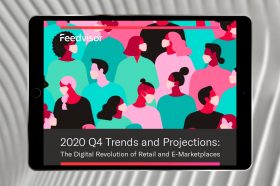Resources - Blog
What Is Performance Marketing?

Stay on top of the latest e-commerce and marketplace trends.
Anyone in advertising knows that the power of traditional campaigns is waning. Technology has drastically changed the type of media that advertising uses and how much consumers can control what they see.
Previously, people could change television stations when commercials aired; now, they can stream shows without any ads. The same applies to social media. Rather than reading a magazine, we scroll through Facebook and Instagram feeds, viewing content that is curated based on our browsing habits.
To stay relevant in a marketplace-driven retail ecosystem, brands now need to advertise and reach customers in new ways. To drive sales and grow customer retention, digital marketing (generally defined as marketing campaigns that use online technologies to reach their target audiences) must be at the heart of any e-commerce campaign.
This can take many forms, but the key issue to remember is that all versions can involve performance marketing. The simplest definition of this is marketing that is paid for according to how it performs or the return on investment (ROI) it delivers.
Unpacking what that means a little further requires careful analysis and quantification of customer actions.
Since advertisers are only paid when they produce results, they need to be able to describe and enumerate those results in minute detail. This could mean tracking how often shoppers redeeming a free coupon at a brick-and-mortar store ended up buying other products, too. When this happens, the store can see the value of handing out free coupons, as they led to extra sales.
In the digital arena of e-commerce stores like on Amazon, the tracking of marketing campaigns, and their results becomes far more refined. Every single conversion can be measured, including purchases, signing up for mailing lists, answering questionnaires, and redeeming virtual coupons.
With split tests, it is even possible to demonstrate how many more conversions were generated with one advertising tactic versus another. No single channel will reach all target audience members, especially in a post-coronavirus world where opinions, habits, behaviors, and needs are changing.
That is why today’s most successful strategies use several different platforms simultaneously. This allows for performance on each channel to be analyzed, quantified, and billed for. Additionally, a multi-tiered approach provides retailers with a complete overview of how their campaigns have driven conversions and achieved the best ROI.
Successful performance-based marketing involves using cutting-edge tools that can analyze current trends and behaviors, and then making executive decisions by leveraging that knowledge to create more conversions and sales. These decisions can be automated or made by account managers.
Below, we take a closer look at the metrics, tools, and roles that make up performance marketing.
20% of shoppers start their retail journey with a Google search.
Performance Marketing Metrics and Tools
The digital resources that can be used in performance-based marketing are:
1. Search Engine Optimization (SEO)
Onsite and offsite SEO is essential in a world where as many as 20% of shoppers start their retail journey with a Google search. With search engine algorithms constantly changing, SEO strategies should be reviewed and tweaked on an ongoing basis.
Most people will start with a straightforward search, such as “women’s work blouses,” and then become more specific as they see examples and refine what they are looking for.
For instance, “women’s work blouses with collars” or “women’s work blouses with buttons” could follow. Smart SEO will continue to direct customers to your site with their altered search phrases.
2. Paid Advertising
Ranking high on the search engine results page (SERPs) can take anywhere between three and six months — or longer if you occupy a niche market. To augment SEO efforts and get brands off to a stronger start, business owners should also consider paid advertising. Also known as paid search campaigns, this involves using channels like Google AdWords.
When you pay for advertising, you are essentially buying a top spot on the first page of search results. This will catch customers’ eye and is often enough to make them choose your company, especially if they are not brand loyal or are searching for a product or service for the first time.
3. Content Marketing
Simple blog posts, providing a platform for feedback and reviews, and other engaging articles, such as buyers’ guides, can go a long way toward boosting conversion rates — the more engaging the content, the better.
If your website focuses on women’s apparel and you publish a blog on the latest trends for an upcoming season with links to relevant products, you can expect a good upturn in sales. Similarly, a DIY vendor that runs social media posts on completing a bathroom installation project should provide links to the retail pages of all the products that are used.
4. Email Marketing
Advertisers need to evolve the way they use email marketing, as this platform can still play a huge part in online shoppers’ experiences. Customers often email their queries, invoices are sent out this way, and companies can send reminders about abandoned shopping carts.
Scheduled campaigns often spur buyers on to make additional purchases, as do discount vouchers. Uber’s tasteful emails with clear language, quick calls to action, and impressive discounts are some of the best examples of this kind of campaign.
The salient point here is that in email advertising, less is more. Long, wordy messages do not look very appealing and often fail to catch the consumers’ attention. Instead, you need to create a punchy title for the subject line and keep the information short and to the point, with attractive graphics adding impact.
5. Social Media Marketing
Companies tend to think of social media marketing campaigns as the new version of radio, television, and print adverts.
Attractive or humorous social media posts have the same benefits as these traditional channels and can increase peoples’ good feelings towards a brand or desire to buy more products in the same way.
A home improvement company that helps disadvantaged neighborhoods with building projects could post photos of their efforts on Facebook, and they could be seen by individuals interested in social development and DIY. Both demographics could then click on the pictures for more information.
These posts pack an even bigger punch because they can be linked to blogs, e-commerce retail sites, or other outside pages. This way, they are seen more frequently and make actions easier for viewers to complete. The more views that all of these pages rack up, the higher they rank in search engine results.
6. Display Advertising
With so many other forms of marketing, simple display advertising is not as effective as it used to be. People are quite wary of, as some say, “getting sold at,” and the banners, interstitial ads (websites that audiences are taken to before their target landing site), and rich media (video, audio, and clickable elements) can feel impersonal.
However, strategic display advertising can reach the target audience effectively. The best use of display ads is on very specific websites (if you sell camping equipment, you might consider a banner on an outdoor magazine site) and retargeting campaigns. Here, individuals who have already visited your website are served ads encouraging them to return.
7. Affiliate Marketing
Affiliates are retailers’ marketing partners and drive advertising online. They promote a company’s products or services and receive a commission every time their marketing efforts generate a sale.
This marketing can be in the form of a blog, e-magazine, or specific interest site (like crafts or the outdoors). There are also dedicated affiliate platforms such as coupons and review websites. Not only is it effective but it is also easy to track the performance by the clicks that take customers from the affiliate’s page to the retailer’s website.
Influencers on Instagram and other social media platforms form an additional and increasingly large part of the affiliate marketing group. Skim through social posts on any given day, and you will see celebrities or experts in specific fields all touting various products. The key is to find the influencers that resonate with your target audience.
Tracking Performance Marketing Metrics
The use of artificial intelligence and machine learning has made tracking performance metrics simple and straightforward. The raw data can be overwhelming, but sophisticated algorithms and digital products break it down for you.
Measuring website traffic, lead generation, repeat visits, customer engagement, and sales (the ultimate goal) is easy thanks to sophisticated algorithms that use split tests and other tools.
With this information, it is possible to adjust campaigns so that they better reach target audiences or lead to more conversions. Also, businesses only pay for performance-based marketing once it yields tangible results.
The cost profiles involved are usually:
- Cost Per Click (CPC): Companies pay for each click an ad receives.
- Cost Per Impression (CPI): Companies pay for every 1,000 times their advert is shown.
- Cost Per Lead (CPL): Companies pay for every sign-up they receive as a direct result of their advertisement.
- Cost Per Acquisition: Companies pay every time their advert leads directly to a pre-specific action, such as form completion or loyalty club registration.
- Cost Per Sale: Companies pay for every sale that results directly from the advertisement.
Performance Marketing Roles
The roles in a successful performance-based marketing strategy are all essential and equally interdependent.
The four main positions are:
1. Retailers
Also known as merchants or advertisers, retailers are the businesses that are trying to sell a product or service.
2. Publishers
Publishers are the affiliates retained for specific advertising campaigns. Using social media affiliates can be especially beneficial and a win-win situation for both parties. Brands enjoy increased exposure, publishers make more money, and the loyalty they each develop is transferred onto each other.
3. Managers or Agencies
Many business executives handle their advertising campaigns themselves, especially if they are a smaller enterprise. In other operations, in-house managers or outsourced agencies may be called upon to focus specifically on this role.
4. Networks and Tracking Platforms
A variety of online tools can be utilized for marketing and tracking the performance of your campaigns. In-house or outsourced managers make use of them, and small business managers can try them out themselves if their company does not require the expertise of a seasoned professional.
Final Thoughts
E-commerce was a huge industry before COVID-19, and it has only grown larger since. The question is no longer whether a company should sell and advertise on digital platforms; it is exactly how they should go about doing so.
For many businesses, performance-based marketing — and its exceptional ROI — is the clear answer. Accurately measured results are dynamic and allow executives to make real-time decisions that drive up conversions and profits so that they deliver more and better meet bottom lines.
The only real disadvantage is for the advertisers since they assume all of the risk and are only paid if their campaigns perform and lead to conversions. For retailers, there is minimal risk for potentially great rewards.
Learn what Feedvisor can do for your business.
When you partner with Feedvisor, you automatically receive access to our true, AI-driven technology and hands-on team of e-commerce experts. Contact one of our team members today to learn more about our end-to-end solution for brands and large sellers on Amazon, Walmart, and e-marketplaces.




